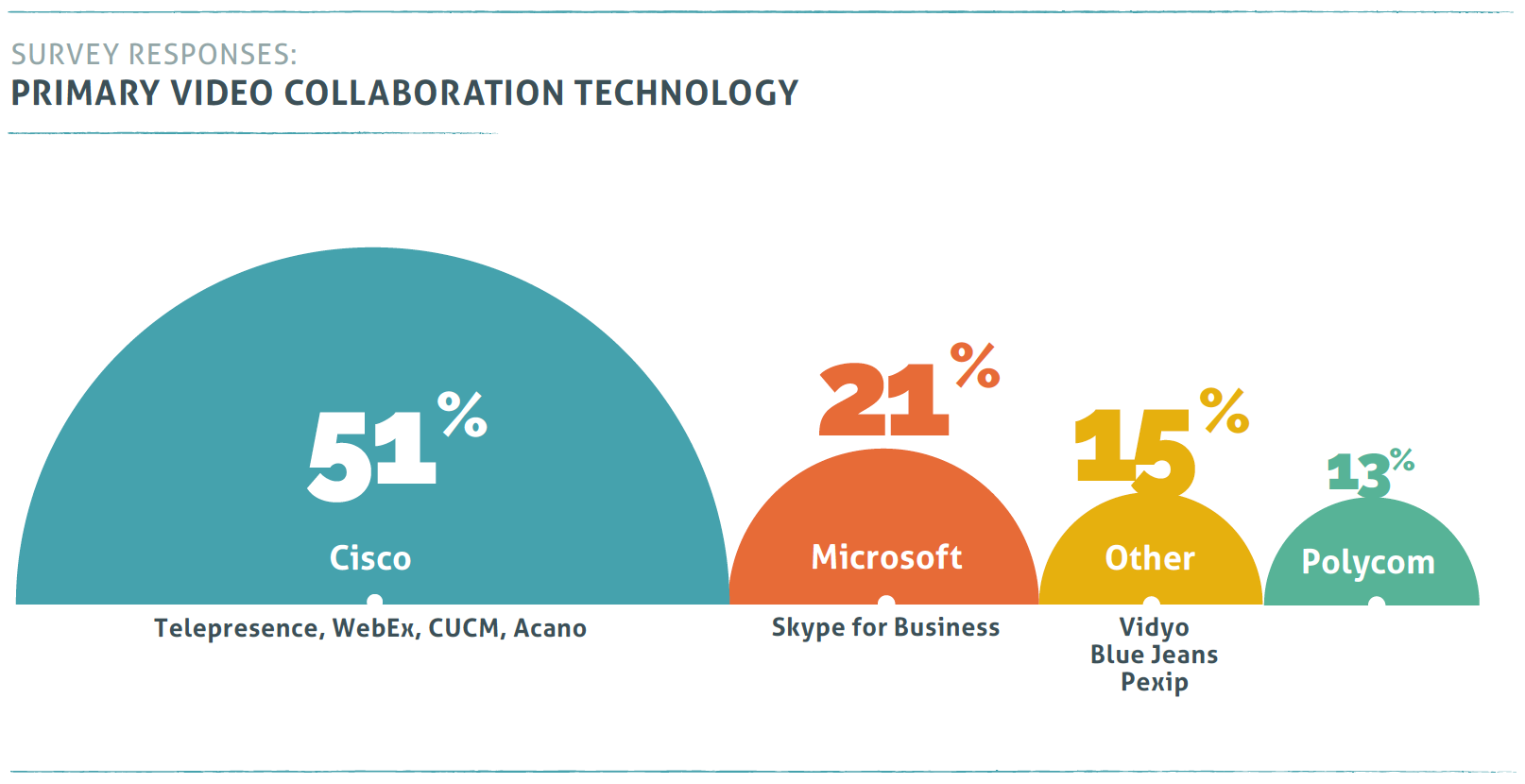“The shift to cloud” is household phrase these days. It’s cool, it’s innovative, and (in most cases) it’s happening. However, in the video conferencing market, this phrase is being stretched and bent by popular publications just enough to spawn assumptions.
Yes, it’s really exciting to think there is a major upset about to happen in the near future, but it’s unlikely.
Let’s debunk any misinterpretations you may have what’s happening with on-premise vs. cloud-based video conferencing solutions by taking a look at the facts, shall we?
Cisco #1 Primary Video Conferencing Solution
We recently put together avideo call quality mini report based on survey responses from a 150+ enterprise industries. It was no surprise when we found Cisco dominating as the #1, video conferencing technology being used by large business. In fact, 51% are using either Cisco Telepresence, Cisco WebEx, Cisco’s Unified Collaboration Manager, or Acano.
Here is the survey results breakdown found in our mini report:

Congrats, Cisco! There is no doubt you are (and have been) the King Kong of the video conferencing market.
The Skype for Business Surprise!
However, we found something quite interesting happening in the #2 slot of this survey question. Microsoft Skype for Business snuck in with 21% of survey responses.
This got me thinking.
There’s has been quite a lot of buzz around Skype for Business and the overall “shift to cloud” in the video conferencing market. Nearly every leading tech publication is stating how cloud-based solutions are on the rise.
- Cloud Breathes Fresh Life Into Video Conferencing Market – Computer Weekly
- Cloud-Based Video Conferencing Gathers Steam – Search Unified Communications
Plus, you have Unify Square making predictions like, “Skype for Business Has the Potential to Exceed 100 Million Enterprise seats by 2018.”
This type of headlines and market predictions has made it quite easy to envision the market looking something like this:

Now, I’m not at all denying that Microsoft Skype for Business, and other cloud-based offerings, are making a huge splash in the collaboration world. They absolutely are! What I am saying is that publications such as Forbes stating that cloud-based solutions are so innovative they’re, “propelling the video conferencing and collaboration market forward,” leaves some room for misinterpretation.
Yes, these reports and predictions may be true. Yes, cloud-based offerings are making a huge impact on the video conferencing market, but I don’t know that there will be an on-premise vs. cloud-based brawl happening anytime soon.
Although, it would be pretty amazing to watch, wouldn’t it? I’m not encouraging it, I’m just saying I’d be front and center with popcorn if it did happen.
Misreading the Video Conferencing “Shift to Cloud”
Statements like those above are frequent. Saying there is a “shift to cloud” occurring is nothing new. Yet, what these statements do is make is seem that on-premise solutions, are on their way out. Most of them go on to spout statistics and predictions indicating the market is going to flip from on-premise to cloud – fast.
In my opinion, this is incorrect.
What most publications do not include is that on-premise solutions are still very much alive and kicking in the enterprise space.
Why would they? It’s not nearly as fun and click-batey.
I enjoy articles like this from publications like PC Magazine. Although they state that the video conferencing market is undergoing massive growth, they include vital information about what the future holds for on-premise solutions. In their recent article they state, “room-based, video conferencing will continue to get smoother, smarter, and more affordable while operating at higher internet speeds.”
It’s far more clear to me they are putting in the legwork and don’t want to get knee-jerk reactions from their readers. Their readers know, “the cloud” is not replacing on-premise video conferencing, it’s just helping to keep the market competitive.
The Latest On-Premise Video Conferencing Vendors
If anyone is to take a look at some of the most recent additions and updates from some of the leading video conferencing vendors, they would know on-premise isn’t going anywhere soon. Here’s are just a few things happening in the few past months:
- May 25, 2016: Prize-winning design quality: Polycom® RealPresence Trio™ triumphs in Red Dot Award: Product Design 2016
- June 1, 2016: Medical University of South Carolina Selects Vidyo Integrated with Epic to Enable High-Quality Telehealth Visits in Electronic Health Record Portals
- July 11, 2016: Cisco Closes ‘Security Effectiveness Gap’ with New Services and Integrated Cloud-Based Solutions
- July 12, 2016: Arkadin and Pexip Announce Strategic Partnership to Deliver More Efficient and Productive Virtual Meetings
Pretty impressive stuff, including some cloud-based integrations. On-premise solutions are obviously leaning into the cloud movement, and/or are working to ensure they offer something cloud-based solutions cannot so they can keep their place in the market. I’d advise staying tuned in by subscribing to each video conferencing vendor’s newsroom.
Oh, and if you haven’t heard, Cisco acquired Acano earlier this year. So, those two industry forces are about to release some amazing new stuff. It’s pretty exciting.
Backing It Up With Survey Data
Ok, so if you’re still skeptical, we asked our survey participants to share the ratio of on-premise vs cloud-based solutions within their organization. It turns out 45% of participants have mix of both on-premise and cloud-based solutions. Meanwhile, 38% support only on-premise, and 12% have only cloud-based.

Roughly 83% use on-premise as a significant portion of their video conferencing portfolio. I’d say this whole “shift to cloud” movement that’s sweeping the industry, is obviously not happening as quickly as we thought. Instead, it seems that enterprises are hanging onto their on-premise investments, and adding cloud-based solutions into their video conferencing environments.
The Impact on IT Teams
Although cloud-based video conferencing solutions are not taking over the market as many publications are leading us to believe, they are making your environment more complicated to manage. Enterprise companies have made a large investments in their on-premise video technology, so it’s staying put (and getting better). Meanwhile, those cloud-based offerings are absolutely being added into the mix.
This means that you’ll not only have to continue to ensure your video conferencing environment is up and running but trying to improve video call quality is about to feel impossible.
Good thing we just put together an entire Mini Guide: Improving Video Call Quality to help you better understand what’s truly happening the video conferencing market, and get ahead of the curve on quality. We’ll share survey results, expert advice, video quality benchmarks, success metrics, productivity formulas, and more!






